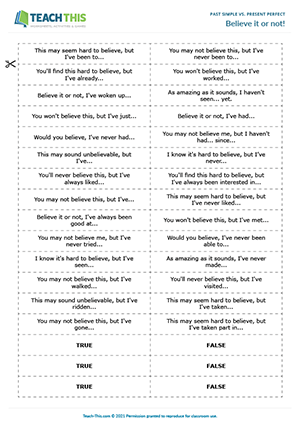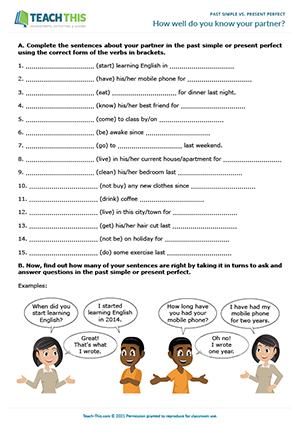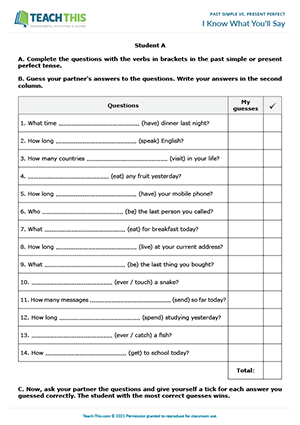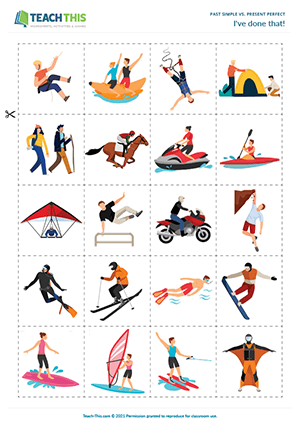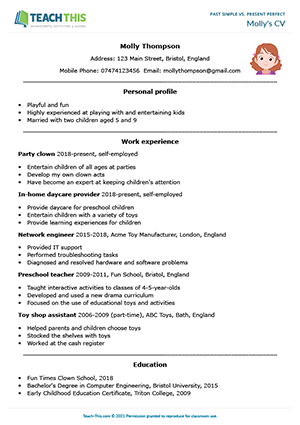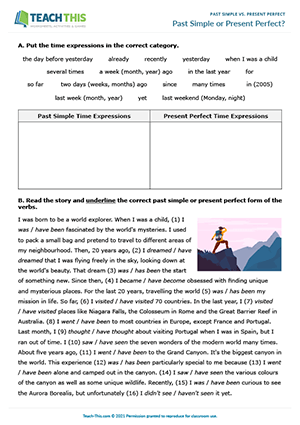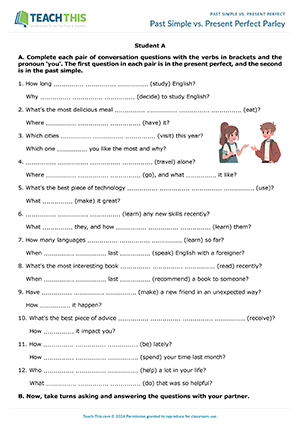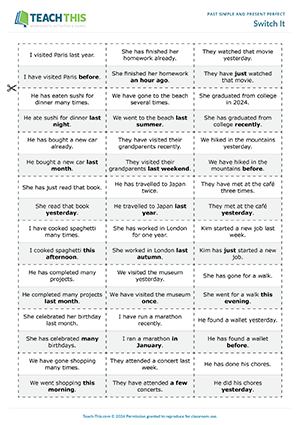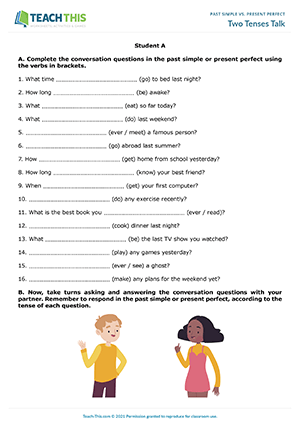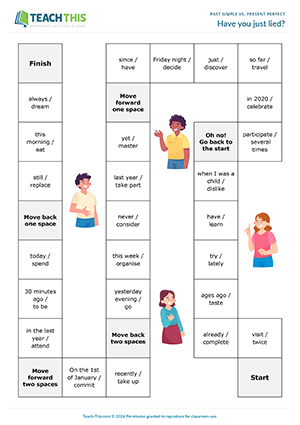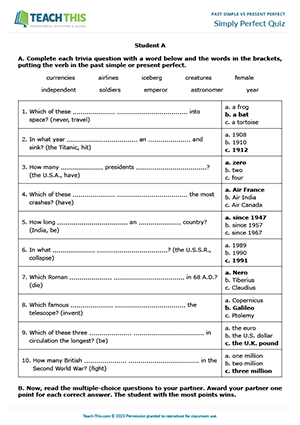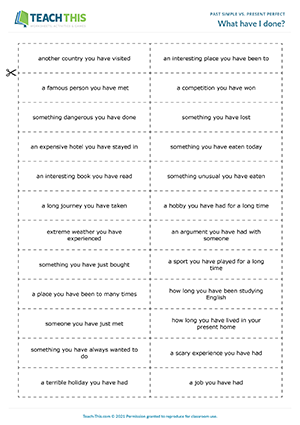In this amusing past simple and present perfect game, students make surprising true or false present perfect statements about themselves and their classmates determine whether they are lying or telling the truth by asking past simple follow-up questions. Players take turns picking up a sentence card and a true or false card. If the player picks up a true card, they make a true present perfect statement about themselves from the prompt on the card. If the player picks up a false card, they make a false statement but pretend it is true. The other group members then take turns asking past simple follow-up questions to the player to try to determine whether the statement is true or false. After a few questions have been asked, each group member decides if the player's statement is true or false. The player then reveals the answer. Each group member who guessed correctly scores a point. The student with the most points at the end of the game is the winner.
In this free past simple vs. present perfect game, students see how well they know a partner by completing sentences about them and then verifying the information by asking and answering questions. First, students complete sentences about a partner in the past simple or present perfect using the correct form of the verbs in brackets, e.g. 'James started learning English in 1990.' 'James has had his mobile phone for six months.' Next, students prepare the past simple and present perfect questions they need to ask to find out if their sentences are correct, e.g. 'When did you start learning English?' 'How long have you had your mobile phone?' Students then take turns asking and answering questions in the past simple or present perfect to find out how many of their sentences are right. Students score themselves one point for each correct sentence. The student with the highest score wins the game.
This fun past simple vs. present perfect game helps students practice forming, asking and answering questions in the past simple and present perfect tense. To begin, in two groups, students complete questions with verbs in brackets in the past simple or present perfect. Next, students pair up with someone from the other group. Working alone, students predict their partner's answers to the questions and write them down. After that, students take turns asking the questions to their partner, who responds using the past simple or present perfect as appropriate. For each correct guess, students put a tick. The student with the most correct guesses wins the game.
In this engaging past simple and present perfect game, students make true or false present perfect statements and ask past simple Wh questions to find out the truth. In groups, students take turns picking up a picture card and making a present perfect statement, telling the rest of the group they have done the activity on the card, regardless of whether it's true or not, e.g. 'I have been rollerblading.' The group members then find out if the student is lying or telling the truth by asking past simple Wh questions about the details, e.g. 'Where did you go rollerblading?' After the student has answered a few questions, each group member guesses whether it's true or not. The student then reveals the answer. Each group member who guessed correctly scores a point. The student with the most points at the end of the game wins.
In this useful past simple and present perfect worksheet, students read a CV for a person applying to be a toy tester and complete exercises using the past simple and present perfect. To start, students read Molly's CV and label statements about Molly as true or false. Students then read Molly's cover letter and write each verb in brackets in the past simple or the present perfect. Lastly, students write past simple or present perfect questions for a set of answers about Molly. As an extension, brainstorm past simple and present perfect questions that a job interviewer might ask Molly when applying for a job as a toy tester. In pairs, students then role-play a job interview with one student being Molly and the other student being the interviewer.
In this comprehensive past simple and present perfect worksheet, students practice past simple and present perfect time expressions. Students start by putting time expressions into the correct category, according to whether they are past simple time expressions or present perfect time expressions. Next, students read a story and underline either the past simple or present perfect form of the verbs using the time expressions in the text to help them. Students then complete past simple and present perfect sentences with the correct form of the verbs in brackets. After that, students complete sentences with true information about themselves in the past simple or present perfect, according to the time expression in each sentence. Finally, students read their sentences to a partner and discuss them.
This insightful past simple vs. present perfect speaking activity helps students practice forming, asking and answering conversation questions in the past simple and present perfect tense. First, in two groups, students complete each pair of conversation questions with the verbs in brackets and the pronoun 'you'. The first question in each pair is in the present perfect, and the second is in the past simple. Next, students pair up with someone from the other group and take turns asking and answering the conversation questions with their partner, responding in the present perfect or past simple, according to the tense of each question. Afterwards, students share what they found out about their partner with the class.
In this productive past simple vs. present perfect game, students change sentences from the past simple to the present perfect or vice-versa using adverbs or adverbial time expressions. In groups, students take turns picking up a card and reading the top sentence and adverb or adverbial time expression in bold from the bottom sentence to the group, e.g. 'She has lost her phone several times. (last night)' The group members then race to change the sentence into the past simple or present perfect using the adverb or adverbial phrase. The first student to say the bottom sentence on the card wins and keeps the card, e.g. 'She lost her phone last night.' The student with the most cards at the end of the game wins.
In this enjoyable past simple and present perfect speaking activity, students form past simple and present perfect conversation questions and then discuss them with a partner. In two groups, students complete conversation questions in the past simple or present perfect using verbs in brackets. Next, students pair up with a member of the other group and take turns asking and answering the past simple and present perfect conversation questions with their partner. Afterwards, students share what they found out about their partner with the class.
In this fun past simple vs. present perfect board game, students practice using the past simple and present perfect to give true or false information about themselves. Players take turns rolling the dice and moving their counters along the board. When a player lands on a square, they pick up a true or false card and look at it without showing anyone. The player then uses the prompt from the square to make a past simple or present perfect statement about themselves that is either true or false as indicated on the card, and then give additional details. The other students listen to the player's answer to ensure that the past simple and present perfect are used appropriately and then guess whether the player's statement is true or false. The player then reveals the answer. The students who guessed correctly each score one point. If a player can't think of anything to say, makes a grammar mistake, or doesn't give additional information, they move back to their previous square. When a player reaches the finish, the game ends, and the points are added up. The student with the most points wins the game.
In this interesting past simple vs. present perfect activity, students complete trivia questions in the past simple or present perfect and then take part in a quiz using the questions. First, in two groups, students complete each trivia question using the words provided, putting the verbs in the past simple or present perfect tense. When the students have finished, they pair up with someone from the other group. Students then take turns reading each trivia question along with three possible multiple-choice answers to their partner, who tries to guess the correct one. For each correct answer, students score one point. The student with the most points at the end of the quiz wins.
In this entertaining past simple vs. present perfect activity, students play a true or false guessing game to practice the past simple and present perfect. Each member of Team A picks up a card. The cards show something they may or may not have done, but each student in Team A tells Team B they have had the experience, regardless of whether it is true or not. The members of Team A take turns to do this by either giving true or made up details using the present perfect to introduce the experience and the past simple to give details. After each member of Team A has spoken, Team B asks past simple follow-up questions about the student's experience to see if they can work out whether the student is lying or telling the truth. After questioning all the team members, Team B decides who is telling the truth or lying. Team A then reveals the answers. For each correct guess, Team B scores a point. It's then Team B's turn to play. The student with the most points at the end of the game wins.
Latest Free
Resources
- Everyday Objects Bingo
Everyday Objects
Elementary (A1-A2)
- Action Verb Races
Actions
Elementary (A1-A2)
- Birthday Basics
Birthdays
Elementary (A1-A2)
- Sales Phrasal Verbs
Business Phrasal Verbs
Upper-intermediate (B2)
Latest Member
Resources
- Collocations at Work
Business Collocations
Intermediate (B1)
- Etiquette Trivia Board Game
Etiquette and Manners
Upper-intermediate (B2)
- Everyday Objects Vocabulary
Everyday Objects
Pre-intermediate (A2)
- Let's have a talk
Verb-Noun Collocations
Pre-intermediate (A2)



